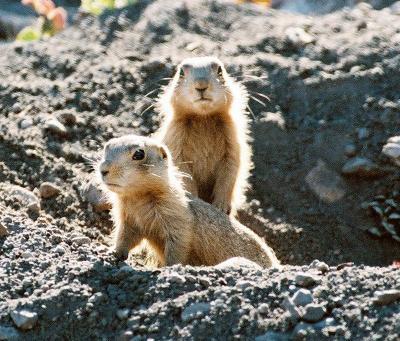Researchers using statistical tools to map social connections in prairie dogs have uncovered relationships that escaped traditional observational techniques, shedding light on prairie dog communities that may help limit the spread of bubonic plague and guide future conservation efforts. The work was done by researchers from North Carolina State University and the National Evolutionary Synthesis Center (NESCent).
"Prairie dogs are increasingly rare and are subject to bubonic plague," says Dr. Jennifer Verdolin, lead author of a paper on the work and an animal behavior researcher at NESCent. "This work improves our understanding of the social dynamics within a prairie dog colony, which could help us find ways to mitigate the spread of plague. It also helps us understand how these social groups are connected, so we can limit the disruption to prairie dog populations when we need to relocate them for conservation purposes."
"This project also emphasizes how useful social network theory can be when applied to population biology," says Amanda Traud, co-author of the paper and a Ph.D. candidate in biomathematics at NC State. "And we also developed new tools for this project that can be applied elsewhere and help us use social network theory more effectively to study other species.
"For example, we developed new code that can identify individuals that serve as 'hubs' or 'bridges,' connecting different groups within a population," Traud says.
The researchers used data Verdolin collected on three Gunnison's prairie dog (Cynomys gunnisoni) colonies in Arizona, ranging in size from 60 to 200 individuals. Each colony is made up of numerous, smaller social groups that can consist of up to 15 individuals.

Two Gunnison's prairie dogs (Cynomys gunnisoni) are shown.
(Photo Credit: Jennifer Verdolin)
Traud developed statistical tools using social network theory to analyze one year's worth of data on the three colonies, focusing specifically on "greet kissing," in which prairie dogs briefly lock teeth with each other. If individuals are from the same social group, they part amicably. If they are from different groups, they usually fight or chase one another after greet kissing.
By looking at data on greet kissing, Traud established which prairie dogs were in the same group. These groups were consistent with the groups Verdolin had determined, using conventional observational methods of behavior and location.
However, the math-driven social network theory approach also identified substructures within those social groups and key "bridge" individuals that connected different groups – findings that may have significant conservation applications.
"For example, there's a possibility that we could slow or stop the spread of plague in a colony by relocating these bridge individuals," Traud says.
"By the same token," Verdolin says, "conservationists could use this data to be sure to relocate all of a relevant social group, rather than splitting up groups. That could improve the group's chances of thriving in a new environment."
Source: North Carolina State University